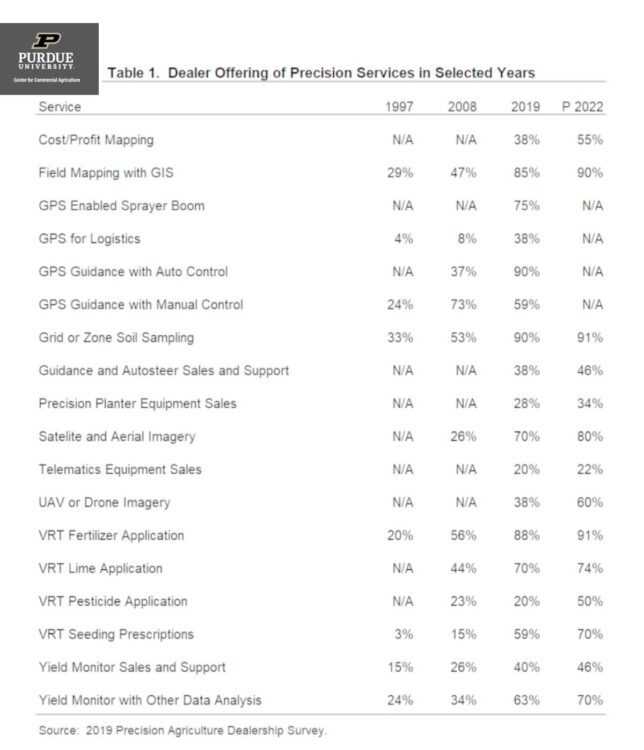March 26, 2021
Adoption of Precision Agriculture Technologies
by: Michael Langemeier and Michael Boehlje
Recent (March 18, 2021, March 12, 2021, March 5, 2021) articles discussed the importance of new technologies to crop agriculture, and the value and role of information in the adoption of these technologies. In this article, we continue this theme by discussing the adoption of precision agriculture technologies. Upcoming articles will discuss the potential payoffs from the adoption of precision agriculture technologies, automation and robotics, and knowledge gaps on farms.
Current Status and Availability of Precision Agriculture Technology
A 2019 survey of agricultural retailers provides a useful perspective of the current state of precision farming technology adoption (Erickson and Lowenberg-DeBoer, 2020). This survey was initiated in 1997, so it provides a historical perspective of the development over time of precision farming technology adoption as well as some evidence of future challenges and opportunities. A total of 165 dealers responded to the 2019 survey. Table 1 summarizes the dealer offerings of precision services in selected years. The information in the last column represents projections for 2022. Entries designated with N/A indicate that this information was not available in a given survey year, or that projections were not available for a particular service. In many cases for 1997 and 2008 a designation of N/A means that the service was not available because the technology was still being developed. The availability of service offerings increased dramatically from 2008 to 2019. Services that were offered by more than two-thirds of the dealers in 2019 included field mapping with GIS, GPS enabled sprayer boom, GPS guidance with auto control, grid or zone soil sampling, satellite and aerial imagery, VRT fertilizer application, and VRT lime application. Interestingly, cost/profit mapping, guidance and autosteer sales and support, and UAV or drone imagery went from not being offered or surveyed in 2008 to 38% in 2019, and are projected to increase significantly by 2022.

Table 1. Dealer Offering of Precision Services in Selected Years
A 2019 survey of 800 commercial farmers (1000 acres or larger in size) by Purdue’s Center for Commercial Agriculture (Thompson et al, 2019) provides further insight on issues of precision agriculture technology adoption, and data analysis and utilization. Results indicate that a large proportion of farmers with 2000 or more operated acres collect yield monitor (approximately 75%), soil sample (approximately 85%), and imagery (close to 90%) data. This data has the highest influence on fertilizer decisions, seeding rate decisions, and drainage decisions. Survey respondents appeared to be very satisfied with the results: 72% report a positive yield impact from data-driven seeding rate decisions; 81% from fertilizer decisions, and 85% from drainage decisions. Collecting data from all three sources results in even more satisfaction with the results than if only one data stream is collected. As to data management practices, 47% of the farms collecting data use one or more data software products/services; 63% of farmers with 5000 acres or more use at least one data software product/service. In terms of data sharing, over 70% share their farm data with at least one service provider. Farmers who subscribe to a data software platform or share their data with an outside service provider are more “highly influenced” by the data in their seeding and fertility decisions than those who collect data but do not use a platform or share their data.
Lowenberg-DeBoer and Erickson (2019) provide an excellent review of the research that has been done internationally on the adoption of precision agriculture technology. The authors noted that guidance systems, sprayer boom control, and planter row or section shutoffs are becoming standard practice in mechanized agriculture, and have been adopted in some cases as rapidly as GM seed. However, the adoption of VRT has be slower, suggesting that it is more difficult to access the benefit/cost relationship for these technologies. The authors noted that adoption of VRT technologies are likely to expand with robotics and AI.
What about the profitability of adopting precision agriculture technology? Schimmelpfenning (2016) found a small increase (1.1% to 2.8%) in operating profit for corn, and Schimmelpfenning (2018) found a small increase (1.1% to 1.8%) in operating profit for soybeans resulting from the adoption of GPS soil and yield mapping, guidance systems, or VRT. A more recent exploratory study by Pope and Sonka (2020) pertaining to the use of digital technology in farming used a detailed interview survey of a small sample (10) of farmers who are recognized as early adopters of precision farming technology to obtain their estimates of the costs and benefits of approximately 25 individual precision farming tools or practices. Categories of tools and practices included:
- “Legacy Control Systems” (e.g., yield monitors and auto steer)
- “Mapping”
- “Agronomic/Fertility Systems” (e.g., gird/zone soil mapping, variable rate technology, sensors)
- “Monitoring Systems” (e.g., drones or aerial imagery)
- “Decision Support Technologies” (e.g., analytics, management systems)
The perceived average net benefit was almost $90 per acre, and the benefit cost ratio averaged 9.7 to 1. These results suggest a much higher payoff of precision farming than previous studies. This higher payoff is a result of the whole-farm system benefits of the interactions among individual tools and technologies which result in a new way of farming.
As reflected by the specific interview responses of the participants in this study, the payoff of adopting precision farming technologies is well beyond the cost savings and efficiency gains of specific farming practices. It is the “system” benefits of a new way of farming – the interactions among the practices that compound or multiply the benefits of individual practices or technologies and enable the implementation of a more systematic way of farming. These systemic whole-farm benefits are reflected in some of the insights from the farmer interviews reported in that study:
- Understanding rainfall events – knowing when to go to the field
- Knowing what is going on with different hybrids within the field
- Deciding when to cull cash rented fields
- Documentation for crop insurance claims, lenders, landlords, and buyers Facilitates on-farm research
- Leads to savings in machinery investment and costs Provides data for benchmarking with other farmers
- Enables savings in labor costs
- Has made farming easier and less stressful
- Understanding rainfall events – knowing when to go to the field
- Knowing what is going on with different hybrids within the field
- Deciding when to cull cash rented fields
- Documentation for crop insurance claims, lenders, landlords, and buyers Facilitates on-farm research
- Leads to savings in machinery investment and costs Provides data for benchmarking with other farmers
- Enables savings in labor costs
- Has made farming easier and less stressful
New Precision Agriculture Developments
As noted in the discussion above, significant advancements in precision farming technology have been made in the last few years. Given the increased interest in and commitment by venture capitalists, innovators, and entrepreneurs to enhancing the “digitization of everything” in the food production and distribution industry, the development of new tools and technologies should continue at an accelerated pace. What should we be watching to monitor the new advances in precision farming? Here is a partial list:
- Better understanding of the fundamental drivers/determinants/constraints of plant growth and the specific structure and parameters of the underlying growth process.
- Improved technologies to more accurately real-time measure/sense/monitor that growth process.
- Better understanding of how frequently and at what level of granularity (by acre, field, parcel, etc.) to monitor and manage production processes.
- Improvement in the accuracy in measuring outputs (yield, production) and inputs (seed, nutrition, chemicals, tillage, etc.) of crop production processes.
- Further advances in the application and process control technologies that can be used in real- time to manage and intervene in order to enhance plant growth.
- A better understanding and control of the accuracy of “application” technology (seed and fertilizer placement, spray patterns and dosage, tank or batch composition, and concentration, etc.)
- A better understanding of the challenges and opportunities of data aggregation and sharing needed to obtain essential insights in crop production.
- Increased availability of broadband connectivity in rural areas to enable faster and more accurate data transmission and communication.
- Advances in data security systems and resolution of issues concerning privacy and data sharing between farmers and their business partners in the value chain.
- Further advances in cloud computing, artificial intelligence (AI), Big Data, and the Internet of Things (IoT) technologies that will accelerate the digital transformation of the farming sector.
Concluding Comments
This article discussed the adoption of precision agriculture technologies. Adoption rates have been very high during the last ten years, and given the increased venture capital devoted to developing these technologies is likely to continue at an accelerated pace. The next article on this topic will discuss possible payoffs for the agricultural producer, for the value chain, and for the environment associated with the further adoption of precision agriculture tools and technologies. As we expand the toolkit for precision farming and digitization systems and platforms to enhance farmer’s profit margins as well as create value for the value chain and society as a whole, the farming sector will be increasingly transformed from “growing stuff” to biological manufacturing.
References
Boehlje, M. and M. Langemeier. “The Role of Information in Today’s Uncertain Business Climate.” Center for Commercial Agriculture, Purdue University, March 18, 2021.
Boehlje, M. and M. Langemeier. “Information Technology and Value Creation.” Center for Commercial Agriculture, Purdue University, March 12, 2021.
Boehlje, M. and M. Langemeier. “Importance of New Technologies for Crop Farming.” Center for Commercial Agriculture, Purdue University, March 5, 2021.
Erickson, B. and J. Lowenberg-DeBoer. “2019 Precision Agriculture Dealership Survey.” Department of Agricultural Economics and Agronomy, Purdue University, February 2020.
Lowenberg-DeBoer, J. and B. Erickson. “Setting the Record Straight on Precision Agriculture Adoption.” Agronomy Journal. 111(Issue 4, 2019):1552-1569.
Pope, M. and S. Sonka. “Quantifying the Economic Benefits of On-Farm Digital Technologies.” farmdoc daily (10):40, Department of Agricultural and Consumer Economics, University of Illinois at Urbana- Champaign, March 4, 2020.
Schimmelpfenning, D. “Farm Profits and the Adoption of Precision Agriculture.” USDA-ERS, Economic Research Report 217, October 2016.
Schimmelpfenning, D. “Crop Production Costs, Profits, and Ecosystem Stewardship with Precision Agriculture.” Journal of Agricultural and Applied Economics. 50(Issue 1, 2018):81-103.
Thompson, N.M., C. Bir, D.A. Widmar, and J.R. Mintert. “Farmer Perceptions of Precision Agriculture Technology Benefits.” Journal of Agricultural and Applied Economics. 51(Issue 1, 2019):142-163.
TEAM LINKS:
PART OF A SERIES:
RELATED RESOURCES
Margaret Lippsmeyer presented during agri benchmark’s 2024 annual conference in mid June, which was hosted by the Spanish Ministry of Agriculture in Valladolid, Spain. An increase in soybean acreage may come from either (a) shifting away from continuous corn rotations to corn-soy and (b) shifting corn-soy rotations toward corn-soy-soy. Based on agri benchmark data, Margaret showed that option (a) would require an increase in soybean prices of 6% and option (b) of 8% to make these rotations preferable over existing ones.
READ MOREUPCOMING EVENTS
We are taking a short break, but please plan to join us at one of our future programs that is a little farther in the future.






